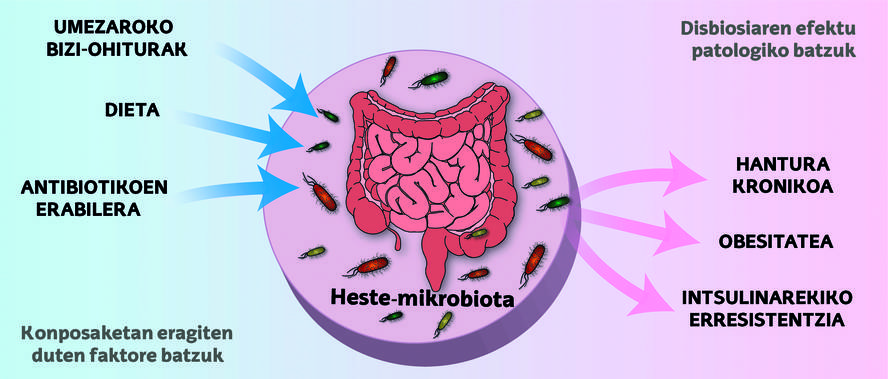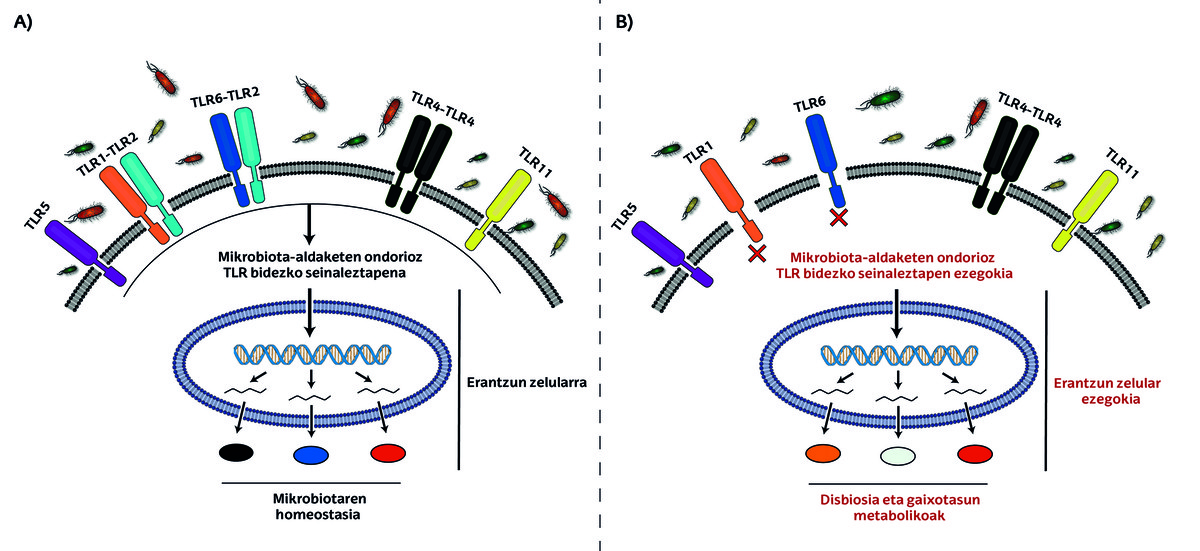Microbiota and metabolic disease
The microbio-metabolism relationship has opened new doors in the research world in recent decades. Our body consists of microorganisms whose balanced composition plays a fundamental role in health. Obesity, diabetes or metabolic syndrome are diseases that can be caused by imbalances in this composition.

In 1914, the philosopher Ortega y Gasset said the famous phrase “I am I and my circumstances”. In this case, the phrase “I am myself and my microbiota” comes to us better.
The microbiota is made up of all the microorganisms that live in our body. It consists mainly of bacteria, but also fungi, yeasts and viruses, among others [1]. How do viruses? Quiet, the relationship between our organism and these microorganisms is generally symbiotic, that is, beneficial for both sides. In fact, they maintain the normal physiological state of the body in a dynamic balance [2] and participate in immunity [3].
The microbiota is found in our body anywhere in contact with the external environment: intestine (famous intestinal flora), mouth, skin and vagina [1]. In total, it contains 38 billion microorganisms, more than 30 billion human body cells [4]. In other words, microbial cells are more abundant in our body than human cells.
The intestinal microbiota or intestinal flora is the most important and variable microbiota. It is characterised by complexity, dynamism and heterogeneity [2].
Complex due to the wide variety of microorganisms. However, as with surnames, there are many groups of bacteria: Firmicutes, Bacteroidetes, Actinomycetes, and Proteus [2]. It is dynamic because it can vary according to diet or lifestyle. Finally, it is heterogeneous because the composition of the intestinal flora varies from one area to another.
As already mentioned, within our body is a passionate microbial world, small organisms that play a fundamental role in our health. Curiously, this microbial community begins to form before birth, as its mother transmits it to the fetus [5].
However, its postnatal development continues, influenced by the method of delivery, diet (breastfeeding or formula), hygiene and use of antibiotics. It should be noted that the first three years of life are indispensable for the formation of a stable microbiota similar to an adult, a microbial community that subsequently significantly influences our immune and neurological system [5].
However, throughout life, the intestinal ecosystem can suffer alterations that affect the delicate balance between the microbes and our body, a situation known as dysbiosis. These changes may cause problems such as inflammation, metabolic disorders or insulin resistance, which increases the risk of metabolic diseases (Figure 1) [5].
The community of microorganisms that inhabits our gut has had a growing scientific interest in recent decades. As the understanding of this biological network deepens, clarifying connections have been found between microbial composition and different health conditions, including diabetes, obesity and metabolic syndrome.
Obesity
We all know what obesity is, but how does the World Health Organization define it? Obesity is an excessive accumulation of fat, dangerous to health [6].
And where does that fat come from? In short, it is the result of a positive energy balance [7]. That is, it occurs when the calories we take from the diet exceed what our body needs to perform its functions.
But why not thicken my friend if he doesn't do sports and eats a lot? Obesity, like most diseases, also depends on genes [8]. But lately it has been seen that the microbe also influences.
One study compared microbes from obese mice and thin mice [9]. Polysaccharides (large and complex sugar molecules) that we cannot digest and absorb mammals can digest the microbes of obese mice by having a few cups for it. Thanks to these scissors called enzymes, polysaccharides are cut into simple sugars that they can absorb.
So in short, obese mice take better advantage of the calories they eat from their microbiota. In fact, feces from obese mice have fewer calories. Therefore, although obese mice and thin mice feed equally, the energy balance of obese mice will be more positive and will accumulate fat. Moreover, by transplanting the microbiota of obese mice into thin mice, thin mice begin to accumulate fat.
All of this can obviously be extrapolated to human beings. And yes, even if it seems boring, microbial manipulation can become an important therapeutic strategy to regulate the energy balance of obese people [7].
Diabetes and metabolic syndrome
We've already seen obesity, but how can we define diabetes and metabolic syndrome? Metabolic syndrome is a set of metabolic abnormalities that refer to the coexistence of various risk factors for the development of cardiovascular disease. Among these metabolic abnormalities is insulin resistance, among others [10]. Diabetes is a chronic disease that occurs when the area does not secrete enough insulin or the body does not use the insulin produced effectively [11]. But what do we talk about when we talk about insulin? Insulin is a hormone that regulates blood glucose levels, blood glucose levels. When the blood glucose concentration is very high, the insulin hormone is released and the concentration is decreased, maintaining adequate regulation [12].

Of course, right? So, to make further progress in this history, the time has come to present the TLR participants!
TLR or Toll-Like Receptors are microscopic antennas that detect signals in our body. These receptors appear in the cells of the intestinal epithelium and regulate bacterial colonization, that is, they maintain the amounts of the different bacteria at an appropriate level [13].
Although there are many subgroups within the TLR family, TLR2 is especially important in diabetes. It is observed that in the intestinal flora of mice without TLR2 receptor there are less bacteria of the genus Bifidobacterium. These bifidobacterium act as patches in the intestine and their lack causes increased intestinal permeability. This will cause bacterial toxins to cross the intestinal epithelium and enter circulation, causing inflammation that will increase the risk of diabetes mellitus. This mechanism allows two treatment possibilities. On the one hand, antibiotics that attack bacteria from other genera can be used to promote the proliferation of bacteria of the genus Bifidobacterium. On the other hand, the microbiota of healthy mice can be transplanted into the intestinal flora of mice without TLR2 [7].
Also, the imbalance of some intestinal bacteria can cause problems directly related to insulin resistance and thus diabetes. As already mentioned, insulin regulates blood glucose levels. If insulin resistance develops, cells in the body will not be able to respond adequately to insulin. In principle, the body can keep blood sugar levels in the normal range by increasing insulin production. However, as insulin resistance worsens and the pancreas cannot continue to generate enough insulin to overcome it, blood glucose levels increase, leading to type II diabetes. Type II diabetes can therefore be understood as a hyperglycaemia caused by insulin resistance [14].
Confirming the above, relationships have been found between microbial composition and insulin resistance in people with type II diabetes [7]. So, the issue of type II diabetes has become clear, but what about type I diabetes? Microbiota can also be associated with type I diabetes, an autoimmune disease that occurs early in life. An autoimmune disease is an alteration produced by the immune system itself that affects the cells of the body itself. In this case, type I diabetes selectively destroys some cells in the area and causes insulin deficiency [15]. Studies in mice and mice have shown that some intestinal bacteria affect the incidence of this disease and that imbalance of TLR and modified composition of the microbiota may lead to type I diabetes [7].
Finally, and continuing with mice, studies with these animals showed that those bred in germ-free environment (with all TLR receptors at an appropriate level) were protected from insulin resistance, obesity and other diseases, despite the fact that the diet provided was high in fat. On the contrary, the colonization of these mice protected with intestinal microbiosis of mice with specific receptor deficiency TLR5 led to a rapid development of metabolic syndrome. The study revealed the relationship between metabolic syndrome and the microbe. As if this were not enough, specific communities of intestinal bacteria related to metabolic syndrome have also been identified in humans [7].
Much remains to be done on the microbiota. Technical advances make it possible to better understand the mechanisms under obesity, diabetes, metabolic syndrome and other diseases, as well as their interrelationships. This opens the door to new possibilities for prevention and treatment in the future, while the burden of these diseases on health systems is expected to be alleviated.
Bibliography
[1] Hou, Kaijian, Zhuo Xun Wu, Xuan Yu Chen, Jing Quan Wang, Dongya Zhang, Chuanxing Xiao, Dan Zhu, Jagadish B. Koya, Liuya Wei, Jilin Li, and Zhe Sheng Chen. 2022. “Microbiota in Health and Diseases.” Signal Transduction and Target Therapy 7(1).
[2] Chen, Yinwei, Jinghua Zhou, and Li Wang. 2021. “Role and Mechanism of Gut Microbiota in Human Disease.” Frontiers in Cellular and Infection Microbiology 11.
[3] Belkaid, Yasmine, and Oliver J. Harrison. 2017. “Homeostatic Immunity and the Microbiota.” Immunity 46(4):562–76.
[4] Sender, Ron, Shai Fuchs, and Ron Milo. 2016. “Revised Estimates for the Number of Human and Bacteria Cells in the Body.” PLoS Biology 14(8). just: 10.1371/journal.pbio.1002533.
[5] Boulangé, Claire L., Ana Luisa Neves, Julien Chilloux, Jeremy K. Nicholson, and Marc Emmanuel Dumas. 2016. “Impact of the Gut Microbiota on Inflammation, Obesity, and Metabolic Disease.” Genome Medicine 8(1).
[6] https://www.who.int/health-topics/obesity#tab=tab_1
[7] Hemarajata, Peera, James Versalovic, and Lucero Dra Lau. 2013. “Political Translations of Clinical Chemistry Human Intestinal Microbiota and Body Metabolism: Assumption of Obesity and Diabetes`Sridevi Diabetes`Sridevi.” Acta Bioquím Clín Latam 47(2):617–45.
[8] Singh, Rajan Kumar, Permendra Kumar, and Kulandaivelu Mahalingam. 2017. “Molecular Genetics of Human Obesity: A Comprehensive Review.” Comptes Rendus - Biologies 340(2):87–108.
[9] Turnbaugh, Peter J., Ruth E. Law, Michael A. Mahowald, Vincent Magrini, Elaine R. Mardis, and Jeffrey I. Gordon. 2006. “An Upgrade-Associated Gut Microbiome with Increased Capacity for Energy Harvest.” Nature 444(7122):1027–31. just: 10.1038/nature05414.
[10] Huang, Paul L. 2009. “A Comprehensive Definition for Metabolic Syndrome.” Disease Models & Mechanisms 2(5–6):231–37. just: 10.1242/dmm.001180.
[11] Darenskaya, M. A. L. I. Kolesnikova, and S. I. Colesnikov. 2021. “Oxidative Stress: Pathogenetic Role in Diabetes Mellitus and Its Complications and Therapeutic Approaches to Correction.” Bulletin of Experimental Biology and Medicine 171(2):179–89. just: 10.1007/s10517-021-05191-7.
[12] Andrali, Sreenath S., Megan L. Sampley, Nathan L. Vanderford, and Sabire Önan. 2008. “Glucose Regulation of Insulin Gene Expression in Pancreatic β-Cells.” Biochemical Journal 415(1):1–10. just: 10.1042/BJ20081029.
[13] Yiu, Jensen H. C. Bernhard Dorweiler, and Connie W. Woo. 2017. “Interaction between Gut Microbiota and Toll-like Receptor: From Immunity to Metabolism.” Journal of Molecular Medicine 95(1):13–20. just: 10.1007/s00109-016-1474-4.
[14] Ta, Azez. 2020. “Hypomagnesemia and Insulin Resistance: Gaining Better Understanding of the Pathophysiology of Type 2 Diabetes.” Diabetes. Insights Biomed 5(4):12. setting: 10.36648/2572-5610.4.4.76.
[15] Chellappan, Dinesh Kumar, Nandhini S. Sivam, Kai Xiang Teoh, Wai Pan Leong, Tai Zhen Fue, Kien Chooi, Nico Khoo, Fam Jia Yi, Jestin Chellian, Lim Lay Cheng, Rajiv Dahiya, Gaurav Guamvi, Sbramvi, Singnmi, Sfray, 2018. “Gene Therapy and Type 1 Diabetes Mellitus.” Biomedicine & Pharmacotherapy 108:1188–1200. just: 10.1016/j.biopha.2018.09.138.





